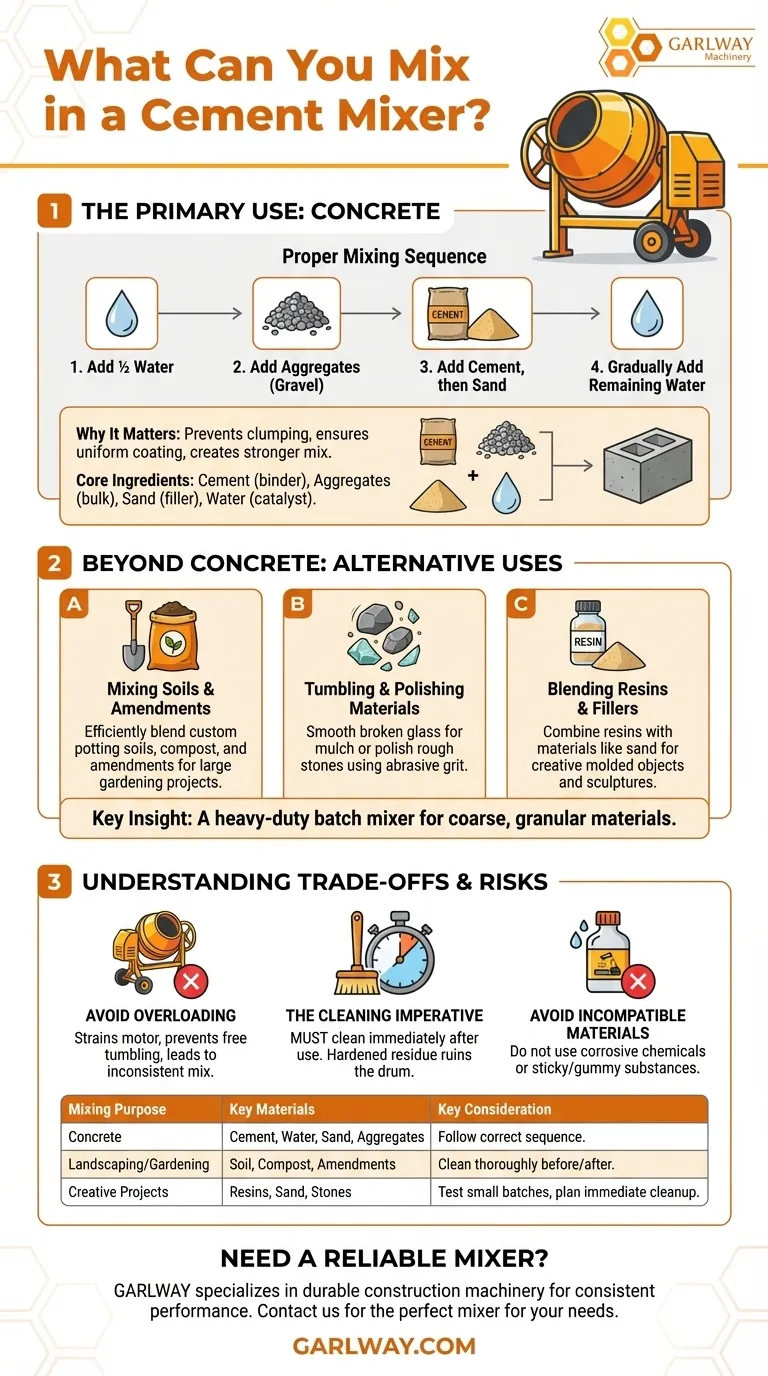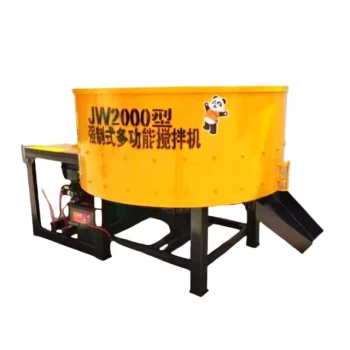At its core, a cement mixer is designed for one primary purpose: to combine cement, water, sand, and aggregates to create concrete. The key to a successful mix lies not just in the ingredients but in the specific sequence they are added to the rotating drum.
A cement mixer is fundamentally a heavy-duty batch mixer. While its design is optimized for creating concrete, it can effectively blend any coarse, granular materials, from garden soils to decorative aggregates, provided you respect its mechanical limitations and clean it meticulously after each use.

The Primary Use: Mixing Concrete Correctly
A cement mixer's main function is to produce a homogenous concrete mixture. Understanding the components and the process is essential for creating a strong, durable final product.
Understanding the Core Ingredients
The classic concrete recipe involves four key elements.
- Cement: A binding powder that, when mixed with water, forms a paste that hardens and binds the other materials together.
- Aggregates: Coarse fillers like gravel or crushed stone that provide the bulk and strength of the concrete.
- Sand: A fine aggregate that fills the voids between the larger aggregates.
- Water: The catalyst that activates the cement and makes the mixture workable.
The Proper Mixing Sequence
The order in which you add materials to the drum is not arbitrary; it is critical for achieving a high-quality mix.
- Add half of your required water to the mixer first.
- Add all your aggregates (gravel). This allows the water to coat them evenly.
- Add the cement, followed by the sand.
- Gradually add the remaining water until you reach the desired consistency.
Why the Order Matters
This specific sequence prevents the cement from clumping and ensures every piece of aggregate is coated with cement paste. This creates a stronger, more uniform mixture, free of weak spots. Adding all the water at once can create a sloppy mix that is difficult to correct.
Beyond Concrete: Alternative Uses
Because a cement mixer is essentially a powerful, rotating drum, its utility can extend beyond just concrete. It excels at blending any large volume of heavy materials.
Mixing Soils and Amendments
For gardeners and landscapers, a cement mixer can be an invaluable tool for creating custom potting soils, blending compost, or mixing soil amendments in large, consistent batches far more efficiently than by hand.
Tumbling and Polishing Materials
The rotating action is perfect for tumbling materials. You can use it to smooth the sharp edges of broken glass with sand, creating a unique decorative mulch for garden beds. It can also be used to polish rough stones with the right abrasive grit.
Blending Resins and Fillers
For creative projects, a mixer can be used to combine materials like sand with an epoxy resin. This allows for the creation of custom-molded objects, pavers, or even large-scale sculptures.
Understanding the Trade-offs and Risks
While versatile, a cement mixer is not indestructible. Using it improperly can lead to poor results or damage to the machine.
The Risk of Overloading
Never fill the mixer to its absolute capacity. Overloading strains the motor and, more importantly, prevents the materials from tumbling freely. This results in a poorly blended, inconsistent mixture. Always mix in manageable batches.
The Cleaning Imperative
This is the most critical rule. Once you are finished, you must clean the mixer immediately and thoroughly. Any concrete, cement, or resin left inside will harden, potentially ruining the drum and rendering the machine useless.
Avoiding Incompatible Materials
Steer clear of highly corrosive chemicals that could damage the metal drum. Likewise, avoid overly sticky or gummy materials that would be nearly impossible to clean out, as the residue could contaminate future batches.
How to Apply This to Your Project
Your goal determines how you should approach using a cement mixer.
- If your primary focus is structural concrete (foundations, slabs): Adhere strictly to the correct ingredient ratios and the proper mixing sequence to ensure maximum strength and durability.
- If your primary focus is landscaping (mixing soil, mulch): The mixer is an excellent time-saver for large batches, but ensure it is completely clean of any cement residue before and after use to avoid contaminating your soil.
- If your primary focus is a creative project (art, custom pavers): The machine offers great potential, but always test a small batch of your materials first and have a clear plan for immediate cleanup.
Ultimately, viewing your cement mixer as a versatile tool for any heavy batch-mixing task unlocks its full potential far beyond the foundation of a building.
Summary Table:
| Mixing Purpose | Key Materials | Key Consideration |
|---|---|---|
| Primary: Concrete | Cement, Water, Sand, Aggregates | Follow the correct mixing sequence for strength. |
| Landscaping/Gardening | Soil, Compost, Amendments | Clean mixer thoroughly before and after use. |
| Creative Projects | Resins, Sand, Stones for Tumbling | Test small batches and plan for immediate cleanup. |
Need a reliable mixer for your construction or landscaping project?
GARLWAY specializes in providing durable construction machinery, including robust cement mixers, winches, and concrete batching plants, for construction companies and contractors worldwide. Our equipment is engineered for consistent performance and efficiency, helping you complete projects on time and to the highest standard.
Contact GARLWAY today to find the perfect mixer for your needs and discover how we can support your business growth!
Visual Guide

Related Products
- HZS75 Concrete Batching Plant Cement Mixer Price Concrete Mixer Bunnings Mixing Plant
- JZC1000 Industrial Concrete Mixer Machine Cement Mixer Price
- Auto Concrete Cement Mixer Machine New
- Concrete Cement Mixer Machine Drum Mixer for Construction
- JDC350 Small Cement Concrete Mortar Mixer
People Also Ask
- How do I choose a cement mixer? Find the Perfect Match for Your Project Scale and Power Needs
- How much does a batching plant cost? Uncover the True Investment for Your Project
- How does ready-mix work? A Guide to Efficient, High-Quality Concrete Delivery
- Can you mix mortar in a cement mixer? Avoid weak joints and project failure.
- Do you put water or cement in a cement mixer first? Master the Professional Layering Method



















